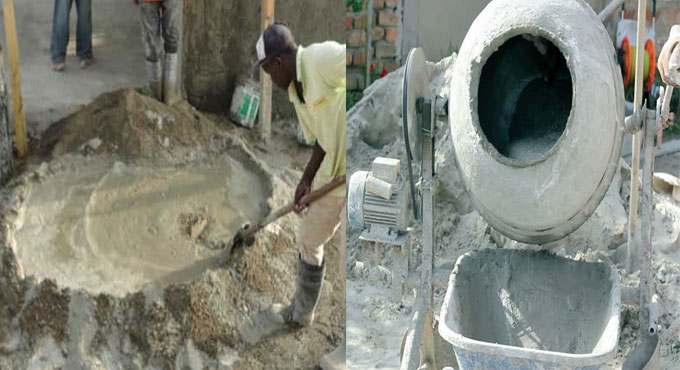
Types of concrete mixing
Once the parting of all concrete constituents is completed, the mixing is started. The mixing process assures consistent mass uniform color. Segregation should not occur throughout the mixing operation.
Mixing is performed with the following processes:
1. Hand Mixing
2. Machine Mixing
1. HAND MIXING: This process is undertaken when there is less quantity of concrete or where mixing machine is unavailable.
Initially cement and sand are blended in dry condition on a clean hard watertight platform. Dry mixing persists unless the mixture gains consistent color. Now, this mix is extended on the measured stock of coarse aggregate in necessary amount and these are blended further to bring consistent color. The mixing is done with shovels.
Create dent in the middle of the mixed pile and include 75% of the required amount of water. Mixing is performed and the leftover quantity of water is added to bring the consistent workability. Under this method of mixing, about 10% more cement is utilized to make up the loss of because of probable draining of water out of the mix and also to sustain the strength characteristic to substandard result of hand mixing.
2. MACHINE MIXING: On big project where concreting work is too heavy, machine mixing of concrete is considered to gain economical benefit. Concrete formed with machine mixing is more consistent and can be developed with relatively less w/c ratio.
The concrete mixers may come in the form of either batch type or continuous type. Batch mixers blend and release each load of materials individually, while continuous mixers generate consistent flow of concrete as long as it is functioning. Latter type mixers are not recommended for general application. Batch type mixers are very effective. These belong to rotary o non-tiling type or tilting type.
A) ROTARY OR NON-TILTING TYPE MIXER: This mixer contains a cylindrical drum supported with a series of inclined blades in it. It rotates about horizontal axis and provides two openings. Charge is received in the drum via one opening and mixed charge is released through the second one. This mixer is found in following capacities. (Concrete formed in a batch in liters).
140 NT, 200 NT, 280 NT, 400 NT and 800NT. (NT indicates Non-tilting).
B) TILTING TYPE MIXER: This mixer contains conical-shaped drum to be rotated about inclined axis. The drum can be tilted in various positions of charging, mixing, and releasing. Blades are fixed inside the drum to be moved through mixing of materials. The materials are charged into the drum by loading skip. These are usable in the following capacities:
100 T, 140 T, and 200 T.
The figures 100, 140 200 etc. denotes capacity in liters of one batch. The normal size of mixer is 200 T. It is a most suitable size and allows a full bag batch of concrete of 1:2:4 ratio. Speed of revolution/minute of mixers is 15 to 20.


